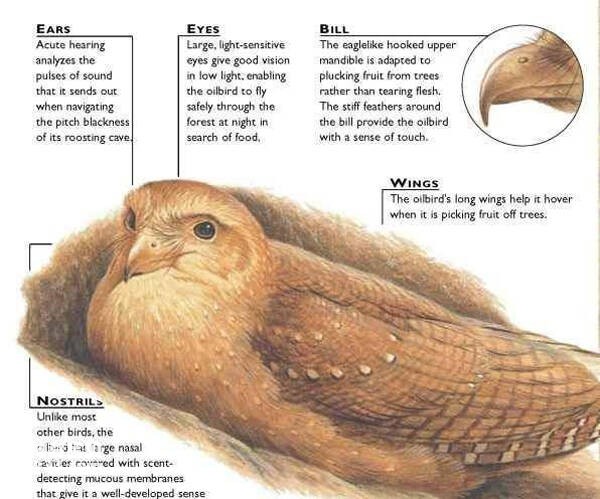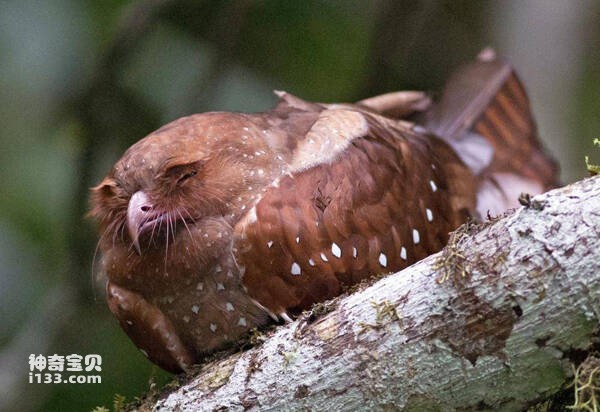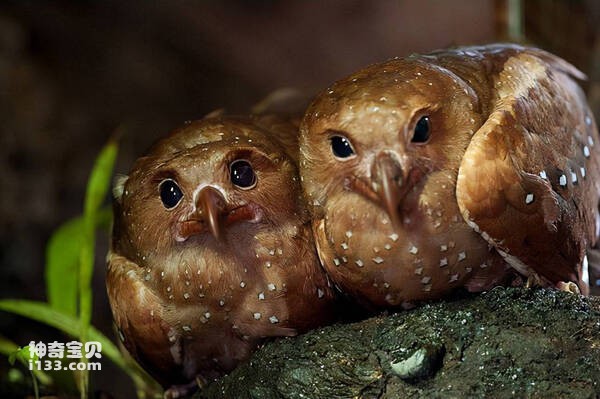Steatornis caripensis
IUCN
LCBasic Information
Scientific classification
- name:Steatornis caripensis
- Scientific Name:Steatornis caripensis,Oilbird,guacharo
- Outline:Climbing birds
- Family:
Vital signs
- length:30-40cm
- Weight:No textual research information is available
- lifetime:No textual research information is available
Feature
It is the only fruit-eating member of the order Nighthawk and has the highest oil content
Distribution and Habitat
Oilbirds are found in the tropical forests of the Andean foothills from Bolivia to Venezuela, as well as in Panama and Trinidad.
Appearance
It is about 30 cm (12 inches) long. Tail fan-shaped, wings long and wide, dark reddish-brown, with black stripes and white spots. The mouth is strong and curved at the end, the mouth is wide, surrounded by long whiskers, and the eyes are large and black.
Details
In the coastal mountains of Colombia, Ecuador and Peru live oilbirds, a close relative of the nighthawk. It's bigger than the whippoorwill and its color is similar to the whippoorwill. According to research, oilbirds are more closely related to owls than nighthawks, and they are also nocturnal birds. However, oilbirds have a very different diet from their close relatives. They eat oil palm fruit. Oilbird mouth is yellow, the tip has a hook, very suitable for pecking fleshy fruit. When dusk falls, large groups of oilbirds fly through the woods, pecking at the palm tree canopy. Their name comes from the thick layer of yellow fat they accumulate under their skin from eating the oily fruits of some plants. Oilbirds' main food source is avocados, oil palm and olives, which are abundant in South America. Avocados have been touted as the king of fruit nutrition in recent years, and their main ingredient is oil. The oil content of an avocado is as high as 20% to 30%, and the oil palm fruit is known as the "world oil king", and the olive fruit is the main source of vegetable oil for humans.

During the breeding season, oilbirds build their nests in hollows in the cave walls. They spit out a slime from their mouths that sticks the partially digested flesh together to form the nest walls. Oilbirds' young have no ability to fly, and most stay in burrows waiting to be fed. Because birds need to consume a huge amount of energy in flight, the Chinese Academy of Sciences bird research data show that it is about 3 to 15 times the energy consumption of land animals running, adult oilbirds eat a lot of oil but fly at night can consume part of it, young birds "dead house" characteristics make their body seriously exceed the standard, look like a meat ball. At around 120 days of baby feeding, these baby oilbirds can grow to 1.5 times their adult weight! Because they contain more oil than adult birds and are easier to catch, starving Indians have relied on them for oil for thousands of years. Every year, when the oilbird breeding season comes, the Indians gather at the mouth of the rock where the oilbird nest is built. They hold a unique ceremony. Then they set up a large pot and a high fire, and drop the thousands of young oilbirds they collect into the pot to make oil. It is said that the oil is transparent and tasteless and does not deteriorate after long storage. The Indians used this oil to light their lamps and eat it.

At night, oilbirds make sharp calls that echo across the mountains. Oilbirds use these echoes to locate food, companions, and obstacles. If the oilbird's ear canal is blocked, the oilbird will only fly in light conditions, which is the same as bats. But unlike bats, the sound waves emitted by oilbirds are within the range of human ears, while the ultrasonic waves emitted by bats are inaudible to human ears. In addition, oilbirds generally emit a loud call frequency below 7,000 Hertz, and in a black hole or encounter an obstacle, their sound is sharper than the common call, and the closer the obstacle, the sharper the call, Griffin determined that the frequency of this scream is above 7,000 Hertz.
In 1958, the Venezuelan government established a national park in the Cabri Cave, and set up a perfect electronic light source in the cave. Since then, thousands of tourists have come to see this strange "bird with radar".
Protect wild animals and eliminate wild meat.
Maintaining ecological balance is everyone's responsibility!








